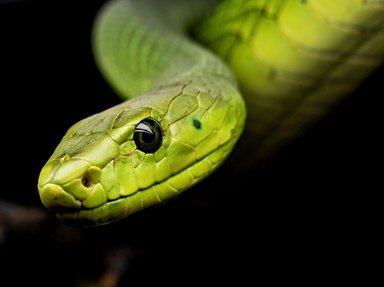Quiz Answer Key and Fun Facts
1. Besides its unique form of locomotion, what is a distinguishing feature of the rattlesnake species known as sidewinder?
2. Often encountered in Florida, Crotalus adamanteus is the largest of all rattlesnakes, and one of the heaviest venomous snakes. By what common name is it known?
3. Crotalus scutulatus is equipped with the most powerful venom of all rattlesnakes. After which large North American desert is it named?
4. Crotalus horridus, the species depicted on the famous Gadsden flag, is the only rattlesnake found in the northeastern US. What renewable natural resource appears in its common name?
5. Commonly known as the bushmaster, Lachesis muta is the longest member of the crotaline family. What does the name "Lachesis" refer to?
6. Bothrops lanceolatus, also known as "fer-de-lance", is a very dangerous snake endemic to which Caribbean island, a French overseas territory?
7. The jararaca is responsible for more than half of Brazil's snakebite cases. Its venom, however, is used to manufacture a number of drugs for the treatment of which common but potentially dangerous health issue?
8. Found in most of the southeastern US, the water moccasin is also known by what other common name, referring to its most distinctive physical feature?
9. Also known as Pallas' pit viper, Gloydius halys is the only crotaline species found in Europe - namely in southwestern Russia, in the vicinity of which large inland body of water?
10. The habu is a large pit viper endemic to the Ryukyu Islands, where it is often hunted and captured for what heady purpose?
Source: Author
LadyNym
This quiz was reviewed by FunTrivia editor
guitargoddess before going online.
Any errors found in FunTrivia content are routinely corrected through our feedback system.
